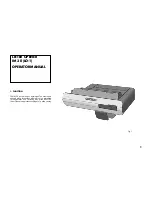
6.3.1 Sieving parameters
Parameters
Average
High percentage of
fine ground material
Sieving time
3...10 min
approx. 15 min
Amplitude
2...2.5 mm
6.3.2 Wetting agents
Wetting agents improve dispersion.
n
Add tensides in liquid form (washing-up liquid, Dusazin etc.) in small
amounts only (dropwise), to prevent frothing.
n
Add inorganic or organic salts like tetrasodium diphosphate or
sodium lauryl sulfate and poly salts in amounts of 0.1 - 0.5 %.
6.3.3 Feeding the rinsing liquid
At the quick-release coupling (N) on the plexiglas clamping lid with 2
rotation nozzles, connect a hose (with hose clamp), through which the
rinsing liquid can be fed. Feed just enough water or alcohol (only possible
with additional pump) to prevent a backup in the sieve set.
The maximum amount of liquid is determined by 2 rotating nozzles on
the clamping lid (approx. 1.5 l/min at approx. 2 bar).
Make sure that the liquid flows evenly out of the wet sieve pan - this is a
sign of good distribution of sieving stock and liquid.
If the liquid stops flowing, it indicates that there is a backup in one of the
sieves. Close the inlet and check the sieves for a possible backup. The
overpressure caused by the backup in the sieve stack can cause irrepar-
able damage to the sieve mesh wire.
If there is a backup in the sieve set, we recommend
reducing the sample quantity, switching on the
"Interval" mode or using the intermediate sieve ring
Chapter 6.3.5 „Tips for wet sieving of difficult
Make sure that the small opening (O) in the wet clamping lid is open -
only then does it prevent overpressure from developing and possible
damage to the sieve mesh wire.
Through this opening (O) in the wet clamping lid, it is also possible to
refill wetting agent if necessary (e.g. with a pipette), as wetting agent
gets washed out during lengthy sieving times.
Using the device
- 27 -
















































